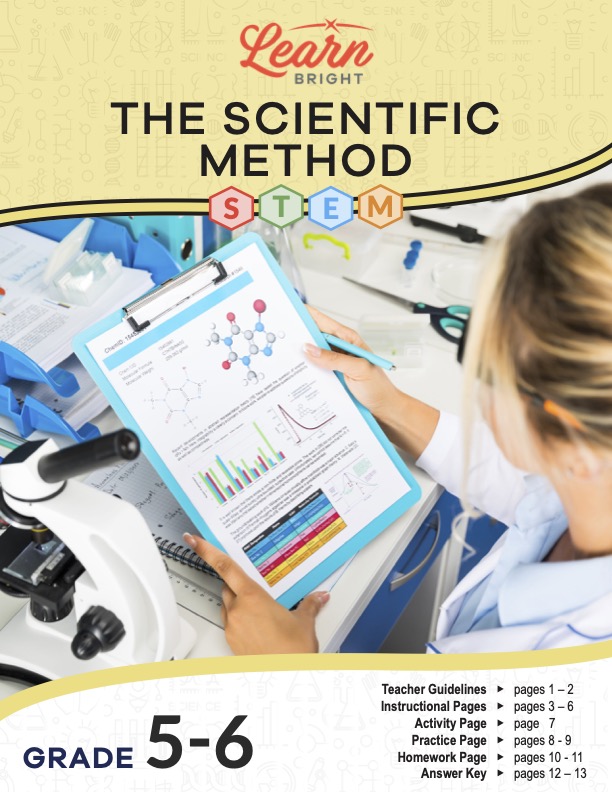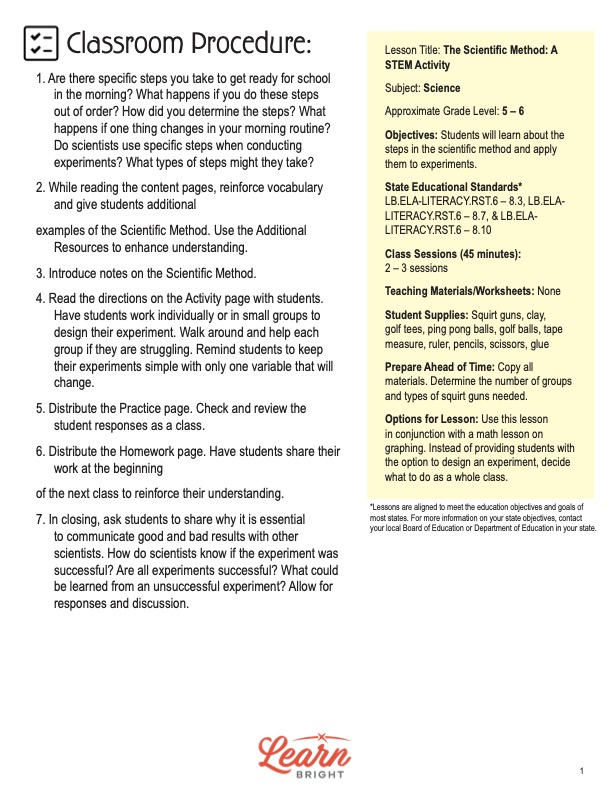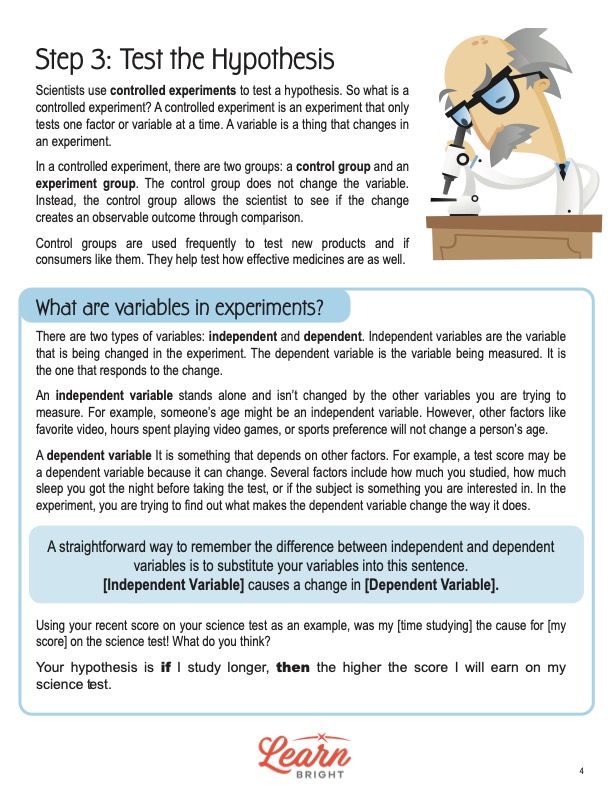Description
What our Scientific Method STEM lesson plan includes
Lesson Objectives and Overview: Scientific Method STEM provides a fun, hand-on experience where students can apply the scientific method to experiments. Students will get the chance to create their own experiments as well. The lesson works very well when combined with other science and math lessons. This lesson is for students in 5th grade and 6th grade.
Classroom Procedure
Every lesson plan provides you with a classroom procedure page that outlines a step-by-step guide to follow. You do not have to follow the guide exactly. The guide helps you organize the lesson and details when to hand out worksheets. It also lists information in the yellow box that you might find useful. You will find the lesson objectives, state standards, and number of class sessions the lesson should take to complete in this area. In addition, it describes the supplies you will need as well as what and how you need to prepare beforehand. For this lesson, you will need squirt guns, clay, golf tees, golf balls, ping pong balls, tape measures, rulers, pencils, scissors, and glue. Students will use these supplies to complete the activity worksheet.
Options for Lesson
The “Options for Lesson” section of the classroom procedure page contains a couple of additional suggestions. However, the bulk of this lesson deals with the hands-on STEM activity. If you want more ideas for extra activities, you can refer to the options for lesson in the Scientific Method lesson plan for 3rd grade and 4th grade. For the Scientific Method – STEM lesson, options include using this lesson in conjunction with a math lesson on graphing. This can assist students in the collect and analyze stage of the process. Another option is to decide as a class what to do for the experiment during the activity.
Teacher Notes
This page provides space for you to write any additional notes you have to prepare for the lesson. It also provides a quick summary of the goal of the lesson and what to expect. In this case, the goal is for students to expand their minds and recognize that they can apply the scientific method to any topic of interest. It also explains that you can use this lesson in conjunction with other science and math lessons.
SCIENTIFIC METHOD STEM LESSON PLAN CONTENT PAGES
Introduction to the Scientific Method
The Scientific Method STEM lesson plan has a total of three pages of content. They detail each step of the scientific method. Students should try to memorize these steps in proper order as they will likely use this process often outside of this lesson. They will first learn that this method helps scientists discover and understand the world by observing events. Science is, after all, a way for people to learn about the natural world and how it works.
Students will discover that they can adapt the scientific method to solve problems in many areas outside traditional fields of science. This is a good time to explain to them how they can ask questions and test their theories for almost any topic, such as sports, food, communication, and so on.
First Three Steps
Make an Observation: This is the first step of the scientific method. Students will learn that they can observe with all five senses, not just their sight. Some experiments require them to listen, taste, feel, or smell. Students will also learn that scientists often make their observations using certain tools or instruments. For instance, they might use a microscope when what they want to see is too small. Or they could use a telescope when the object to observe is really far away.
Form a Hypothesis: The next step is to make a guess as to how to explain a specific observation. Students will learn that a hypothesis is basically a guess as to what they believe the answer is to a question they had after observing an event. The goal is to predict or determine the outcome of the experiment before they actually perform it. Students will see that their hypotheses are often if-then statements. They will also learn that they must be able to test the hypothesis.
Test the Hypothesis: Next, it is time to test out the theory they developed in the previous step. The lesson explains in detail the process of this step and what an experiment often involves. Students will learn about the concept of a “controlled” experiment and why it is essential to a successful experiment. They will also discover that scientists must account for variables of which there are two types: dependent and independent.
Variables in the Scientific Method
It is important that students understand the concept of variables when it comes to experimentation. With controlled experiments, scientists test only one factor or variable at a time. The variable is the thing that changes—all other parts of the study stay the same or are controlled. There are also two groups in this type of experiment. One group, the control group, does not change the variable, and having this group allows scientists to see if the change creates an observable outcome by comparison to the other group, the experiment group.
Back to variables, independent variables stand alone, and other variables don’t change them. Someone’s age, for instance, cannot change despite a person’s favorite sport or the number of hours they play games. On the other hand, dependent variables depend on other factors. A test score could be a dependent variable because it can change according to, say, how many hours someone studied or how much sleep they got the night before.
One easy way for students to remember the difference between the two types of variables is to memorize this sentence: [Independent variable] causes a change in [dependent variable]. Students can substitute various factors in the brackets to see if the statement is true.
Final Three Steps
Collect, Organize, and Analyze the Data: The fourth step is to analyze the data collected from the experiment. These data can be either qualitative or quantitative. The former involve the data that are descriptive, such as an object’s color. The latter involve numerical data. Scientists often use graphs and charts to more easily organize the data and to find patterns.
Draw Conclusions: The next step is to decide whether or not the outcome of the test supports the hypothesis. Students will learn that this step helps them figure out if the answer they theorize to be true actually is true. They will also discover that, even if they are wrong, any experiment they perform is a success. This is because an experiment provides information regardless of its outcome.
Communicate the Results: The last step is important: share the results with others. Scientists share what they learn with others so that they can all learn from each other. Doing so allows others to repeat the experiment to see if they get the same results.
Key Terms
Here is a list of the vocabulary words students will learn in this lesson plan:
- Hypothesis: a theory to explain why a certain event occurred based on one’s observations of the event
- Controlled experiment: an experiment that only tests one factor or variable at a time
- Variable: a factor that changes in an experiment
- Control group: the group that does not change a variable and that allows the scientist to see if the change creates an observable outcome through comparison
- Independent variable: a variable that changes in an experiment
- Dependent variable: the variable a person is trying to measure and that responds to the change
- Qualitative data: descriptive data, such as color or hardness of an object
- Quantitative data: numerical data, such as averages or amounts
SCIENTIFIC METHOD STEM LESSON PLAN WORKSHEETS
The Scientific Method STEM lesson plan has three worksheets: an activity worksheet, a practice worksheet, and a homework assignment. Each of these handouts reinforces students’ comprehension of the material in different ways. This lesson specifically requires the hands-on approach in the activity as it is a STEM lesson. Refer to the classroom procedure page to see when to hand out each worksheet according to the guidelines.
DESIGN AND TEST AN EXPERIMENT ACTIVITY
You can have students work in groups or pairs for the activity, or by themselves. Each student will design an experiment using water guns and supplies. The worksheet outlines each step for the students to follow. For the final step, students will crate a poster that shows each of the six steps that they will later share with the class.
WHAT IS THE ORDER PRACTICE WORKSHEET
The practice worksheet has a table with six rows and two columns. The first column lists the six steps for the scientific method. Students must cut out these slips of paper and rearrange them in the correct order. Then, in the second column, they will draw an icon or symbol that represents each of the six steps.
SCIENTIFIC METHOD STEM HOMEWORK ASSIGNMENT
For the homework assignment, students will pretend they are a famous scientist who wants to conduct an amazing experiment. They will pretend that they have access to any resources they need, as well as an endless amount of money. Then they will create an experiment using the six steps and describe each step in the available space.
Worksheet Answer Keys
The practice and homework worksheets require answer keys. The lesson plan provides the answer keys for each after its respective worksheet. The practice worksheet highlights in red the correct order of the steps of the scientific method. Students’ answers will vary for icon pictures because they will draw them. Therefore, you will need to review the icons student to student. For the homework, students’ answers will also vary. The answer key provides example responses for each step. You may choose to show students this answer key to give them an idea of how they should respond.









